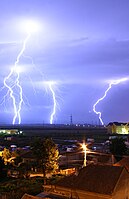
Photo from wikipedia
The plasma-liquid interaction holds great importance for a number of emerging applications such as plasma biomedicine, yet a main fundamental question remains about the nature of the physiochemical processes occurring… Click to show full abstract
The plasma-liquid interaction holds great importance for a number of emerging applications such as plasma biomedicine, yet a main fundamental question remains about the nature of the physiochemical processes occurring at the plasma-liquid interface. In this paper, the interfacial current distribution between helium plasma jet and water solution was measured for the first time by means of the splitting electrode method, which was borrowed from the field of arc plasma. For a plasma plume in continuous mode, it was found that the mean absolute current distribution at the plasma-liquid interface typically had an annular shape. This shape could be affected by regulating the air doping from the surrounding atmosphere, the gas flow rate, the applied voltage and the conductivity of the water solution. However, only the air doping fraction and the water conductivity could fundamentally change the interfacial current distribution from the annular shape to the central maximum shape. It was deduced that a certain amount of ambient air doping (mainly N2 and O2) and a low conductivity (typically < 300 μS/cm) of the treated water were essential for the formation of the annular current distribution at the plasma-liquid interface.
Journal Title: Plasma Sources Science and Technology
Year Published: 2020
Link to full text (if available)
Share on Social Media: Sign Up to like & get
recommendations!